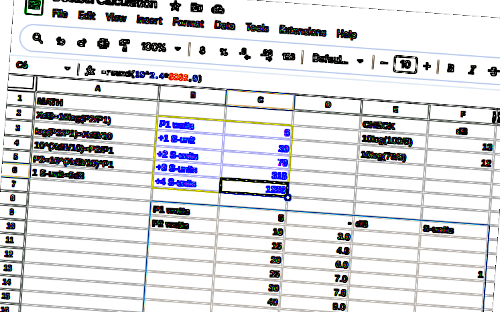If you buy all your equipment and spend most of your on-air time simply chatting to friends, then keep calm and carry on; you are doing us all a favor by keeping the bands alive. Some of us, on the other hand have to take a look “under the hood” to learn what is really going on. We are the experimenters; we build our own antennas, ununs, baluns and chokes. Some even build their own transceivers – it’s relatively easy if you buy a kit.
But, when we sally forth into the world of coils, cores, wires and wireless we inevitably bump into the need to do calculations. Math comes easy to some and not so easy to others, but there is a tool that can level the playing field – it’s called the spreadsheet. By plugging formulas (that we all learned when we studied for our ham exams) into a spreadsheet we can hasten the moment when we complete a project and “let the smoke out” (or hopefully not!).

I have a collection of spreadsheet calculations for various tasks that are commonly encountered between initial idea and solder-smoke stages of a project. Some that I regularly use include:
- Decibel calculations
- Capacitor value conversions (F, uF, nF, pF)
- Capacitors in series calculations
- Resistors in parallel calculations
- Dummy load resistances and power ratings
- Quarter wave stub calculations
- Tuned circuit resonance calculations
- Inductive reactance, capacitive reactance and impedance calculations
It takes a little bit of skill and practice to master the formulas used in spreadsheets, but once you acquire that skill every ham radio design problem looks like a nail for which the proverbial hammer is a spreadsheet. Some years ago I was passionate about monitoring the signals from military satellites in Low Earth Orbit (LEO). Of particular interest were the Russian navigation satellites used by their submarines for precision geo-location. The signals had been previously decoded by a group of enthusiasts in the UK. My contribution was to design a complex spreadsheet that simplified the technique they had used. The publishers of Monitoring Times magazine (now sadly out of publication) kindly agreed to publish my detailed account of the process.
Let’s discuss an example of how a spreadsheet can assist the amateur radio experimenter. Decibels are a straightforward way of comparing the relative strength of two signals, but how many of us know how to actually do the calculations? We all once learned the formula:
XdB = 10log(P2/P1)
This formula compares two signals P1 and P2, each at different power levels. What is the relative strength of the two signals in decibels? For example, how does a QRP signal at 5 watts compare to a standard 100 watt signal? The answer is the QRP signal is 13dB lower. Sounds like a big deal – and sometimes it may well be – but 13dB is only just over 2 S-units. If the bands are good and the 100 watt signal is coming in at S9+, the QRP signal will still be perfect copy at S7 or more. Easy stuff, but let’s turn it around and ask a different question. What power is P2 if it is 4 S-units above P1?
Now we have to really understand logarithms (yikes, college was eons ago!). Something about exponents of the log base wasn’t it? How about we forget about scambling through boxes in the dark and musty basement trying to find those old college electrical engineering textbooks. Let’s just plug this formula into a spreadsheet and watch the electronic mathemagician pull a rabbit out of a hat:
P2 = 10^(XdB/10)*P1
When I went to college one of the first things they taught us was – “a computer is a very fast idiot”; it has to be told how to solve a problem, then performs the task at lightning speed. Nowadays we live in the world of Artificial Intelligence (AI) and I’m not sure that is still true! Incidentally, my major was Applied Physics and the other thing they taught us early in our courses was how to build an atomic bomb. Ah … I think I’ll stick with ham radio!
A computer is a very fast idiot?
Back to our headscratcher: What power is P2 if it is 4 S-units above P1? Well, if we plug those numbers into our spreadsheet it will deliver the answer toute-de-suite. If, for example, P1 is our old friend the humble QRP signal, P2 will be 1256 watts. That’s an eye-opener for anybody considering investing in a big amplifier. If you pump out legal max and get heard at S9, the little guy with a hundred dollar kit rig will be right behind at S5!
As we get older our grey matter begins to decline while at the same time computers get smarter and faster. So here’s my advice: make your own personal computing device work for you before it turns the tables and makes you work for it.
Final note: if I can assist your spreadsheet journey please get in touch either by leaving a comment or sending me an email (address good on QRZ.com). If you have an interesting spreadsheet idea to share please also comment; thanks!
Help support HamRadioOutsidetheBox
No “tip-jar”, “buy me a coffee”, Patreon, or Amazon links here. I enjoy my hobby and I enjoy writing about it. If you would like to support this blog please follow/subscribe using the link at the bottom of my home page, or like, comment (links at the bottom of each post), repost or share links to my posts on social media. If you would like to email me directly you will find my email address on my QRZ.com page. Thank you!
The following copyright notice applies to all content on this blog.

This work is licensed under a Creative Commons Attribution-NonCommercial-NoDerivatives 4.0 International License.
2 thoughts on “Making Math Easy for Ham Radio Experimenters”